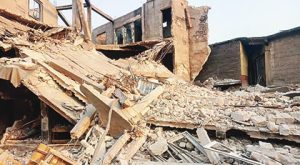
Lara Adejoro
Professor of Community Medicine and Public Health at the University of Lagos and the Lagos University Teaching Hospital, Idi-Araba, Adebayo Onajole, tells LARA ADEJORO how to manage and curb the scourge of the ravaging deadly diphtheria disease
What exactly is this diphtheria disease?
Diphtheria is a bacterial infection that spreads from person to person through airborne, that is air droplets. Usually, it is very common among under-five children, as such, most people get immuned or protected, either because they have had a mild case of the infection or because they have been immunised. The number of cases of diphtheria that we have seen in the past has been very small since we have childhood immunisation of which diphtheria is one of them. They used to call it diphtheria, pertussis, and tetanus. Now, they have added two other vaccines to it, making five which they give in childhood. It is administered at childhood, at six weeks, 10 weeks, and 14 weeks. In most cases, it protects them through life time, but when you have a resurgence of diphtheria, it is likely to be due to low immunisation coverage, which means that most people are not immunised appropriately or that the immunisation administered is ineffective to allow for seroconversion and improved immunity.
The other reasons may be because the vaccines admimistered, may have been not useful either due to the storage processes, or length of storage; all these could have affected its efficacy.
Apart from air droplets, through what other means can it spread?
The only way that is known is through air droplets and it can spread from one person to another. Several factors could however make the spread faster, and these include – overcrowding, high temperature and during the dry season. Short distance radius between a carrier and a prospective victim, could also be a major factor, through wave. If the wave velocity is high, it can also take the droplet to a farther and longer distance than usual. When the temperature is high, bacterial replication is also high. And usually, when it occurs, most of the signs and symptoms that you might notice will be features of an upper respiratory tract infection.
If a victim sneezes or coughs into the atmosphere, it can be inhaled by a neutral person who consequently gets infected. So, being infected depends on many factors – the dosage of exposure, the frequency of exposure, level of exposure, and then, age, is equally a major factor too. The young ones are more likely to come down with it than the older person.
Is it possible that the cases recorded in Kano are due to dry season or high temperature?
The cases in Kano have not been investigated properly, but it could be due to any of the reasons I have given; not being immunised or immunisation not being effective. It could also be a result of reduced immunity, occasioned by many reasons.
One’s immunity could be low, thus paving the way for easy exposure to contract an infection.
Who can be infected and which age group is most affected?
The most infected people are usually under-five children and that has been the cause of the massive investment in immunisation activity that most people would have been exposed to, either through the vaccine or whatever it is. In a few cases, adults may also be exposed if for any reason their level of immunity is reduced.
What are the signs and symptoms of the disease and how long does it take to start manifesting the strains after exposure?
The symptoms are mostly symptoms of upper respiratory tract infection, which include sneezing, coughing, and difficulty in breathing. In some situations, they could have an elevation in temperature but temperature is not very typical of diphtheria. The signs after exposure depend on individuals, but on the average, it is between five and 14 days that you start noticing the signs and symptoms. For some individuals, it could occur much earlier than that.
How serious and contagious is the disease?
It is a disease that may lead to death, especially when it causes respiratory distress or inability to breathe well, because the bacteria affects the lining of the respiratory tract and it can close up the respiratory tract, such that the victim finds it difficult to breathe.
Overall, individual response to the infection depends on victims level of immunity to that infection, how well the victim has been exposed, and the ability to get treatment early. Like I said earlier, it is a bacterial infection and because of that, antibiotics could be very useful when detected early and anibiotics is administered.
Can one get infected more than once?
Yes, but not usually. That is why when we give immunisation in childhood, all three doses of the diphtheria vaccine, you are protected for life, but like I said, other factors could come in like reduction in immunity that could cause reinfection.
How do I know if someone has the disease?
It is very difficult to know because most of the signs and symptoms are atypical – they are things you could have with other respiratory tract infections, especially infections that affect the upper respiratory tract. So, one of those things is that we need to maintain our air hygiene and that has to do with how we cough into the environment, and we need to avoid a crowded environment because the higher one is closer to the source of spread, the more the chances of getting infected.
It is also advisable that suspected victims must seek help early enough when they start to observe some of the signs and symptoms mentioned earlier, most especially when they start getting into respiratory distress. They will need support and anything that could be done like first aid at the healthcare centre to administer antibiotics to the individual concerned.
What is the recommended management and treatment for the disease?
The recommended management is early diagnosis of a high index of suspicion. The diagnosis is more of a swap of microscopic culture and sensitivity most of the time. But the index of suspicion and early treatment will go a long way in alleviating or reducing the morbidity and mortality as a result of the disease. So, victims must visit their primary healthcare physician as early as possible.
When does the use of vaccines come in?
The vaccine is given as a routine childhood immunisation to protect the child from the scourge, especially when there’s an epidemic in an area. There’s there may be the need for vaccination around the location of the diagnosed case. But, most of the time, the resurgence may also be due to a change in the organisms that cause the bacteria; that is, if there is a different strain, but when the disease is contracted and the victim survives it, a good level of immunity is developed against it.
Now that there are cases in Lagos and Kano states and more cases are being picked up in Osun and Yobe states, is there a need to restrict people’s movement?
A restriction is not the issue but avoiding an overcrowded environment is a better way and if the source is somewhere and the wave velocity is high, it can get farther. A restriction is not a way of managing a diphtheria outbreak. What should be done is to put in place proper surveillance processes, and notification, to notify the appropriate healthcare workers in those areas to increase their index of suspicion and management.
Now that there is a resurgence, is there a need for people to be revaccinated?
Yes and no. Yes, because sometimes, we need to do a rapid survey to know that some of us that thought we have been immunised, are really immunised? Then, in areas where cases have been diagnosed, you need to do massive immunisation around the location of identification of sources.
Do adults need to be revaccinated?
When and if you think an epidemic has occurred around that area.
What should Nigerians and the relevant government agencies be doing to curb the spread?
There is the need for increased surveillance, and the introduction of early management with appropriate post-assisted respiration and also antibiotics. We also need to improve our air hygiene culture.
Does Nigeria have the capacity to manage this outbreak?
No disease cannot be managed, it just depends on the attitude of the people who have the disease, the attitude of the people who manage the disease, and the attitude of public health officials and the government to provide resources to manage the disease.
The NCDC has been issuing alerts regarding these cases and we also need to monitor our neighbouring countries so that we know if there are cases there, we can monitor people who are coming from those areas into our environment.
Copyright Reportr Door
All rights reserved. This material, and other digital content on this website, may not be reproduced, published, broadcast, rewritten or redistributed in whole or in part without prior express written permission from Reportr Door.
Contact: [email protected]




